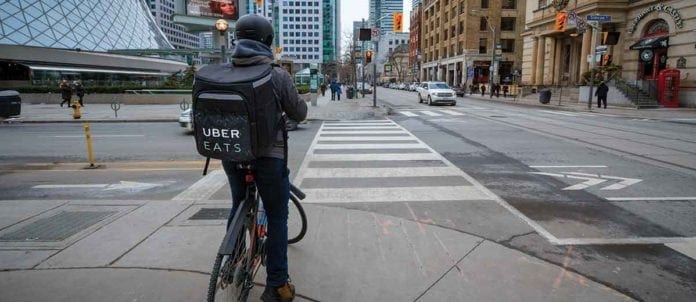Mobile-ordering technology has invaded every aspect of our daily lives as customers reduce their visits to full-service restaurants in an effort to cut spending. According to Vince Sgabellone, foodservice-industry analyst with Toronto-based NPD Group, mobile-ordering apps account for 25 per cent of meal orders — with another 25 per cent coming from the Internet — and that number is growing by double digits.
Sgabellone says customers — especially younger adults — often use delivery as a means of sampling a new restaurant and, “if it goes well, the same customers will tell us they will now visit the restaurant in person,” he says, noting delivery apps done right can be powerful customer-acquisition tools.
Popular delivery apps UberEats, SkipTheDishes and Just Eat currently comprise 40 per cent of the mobile-delivery market, says Sgabellone, thanks in part to their success in partnering with major foodservice operators such as McDonald’s and Jack Astor’s. The remaining 60 per cent of mobile ordering comes from restaurants’ branded apps.
One of the challenges of mobile-delivery apps is the lack of touchpoints that come with dining at a full-service restaurant, such as interaction with the brand and a server to maximize the customer’s experience. This means customers will judge the restaurant based solely on the quality of the food.
Grant Anderson of Stella’s Café and Bakery in Winnipeg found this to be problematic, saying food that is jostled or banged up during delivery reflects negatively on the brand. Instead, Stella’s promotes takeaway options, which allow the brand to have full control of the food. “If you come in to Stella’s and you’ve ordered takeaway, it’s checked by the kitchen and the expeditor. That person reviews the order with you at the counter to make sure it’s correct and you’ve got everything you need — so there’s no surprises when people get home and unpack their order,” says Anderson.
He says delivery “wasn’t really good for who we were,” and he feels using a delivery app took away from the customer experience. Stella’s future may involve an app of some kind, but, for now, Anderson says it will be focusing on face-to-face interaction.
But how can operators decide if a third-party app is right for their business? While partnering with UberEats or other third-party delivery apps saves the time and expense of creating and managing an app, training staff to deliver food and analyzing the countless bytes of customer data, having a proprietary app, developed and managed in-house, can vastly improve a brand’s customer interaction.
“If you can afford it and you can do it properly, you should have your own mobile app,” Sgabellone stresses. Apps should help customers find the nearest location, check out the menu and get access to promotions. Operators can, in turn, communicate with customers and offer special features exclusive to app users.
A leader in mobile-app execution, Vancouver-based Boston Pizza first launched its app in 2014 for iOS, with an Android-based app following in 2016. The MyBP app allows users to order takeout and delivery, see the menu, find a location, save preferred menu items or locations, make reservations at some locations, order gift cards and access the MyBP loyalty program. According to Vicki Waschkowski, senior director, Digital Marketing at BP International Inc., the most recent update features Boston Pizza’s QuickServ program, which allows users to alert their server they need something, split a check and pay their bill.
While a branded app is a great way to gain customer loyalty, partnering with third-party delivery apps can expose restaurants to a wider customer base. It also means the app provider does all the work associated with analyzing the data collected through the app.
Written by Tal Rozin


















